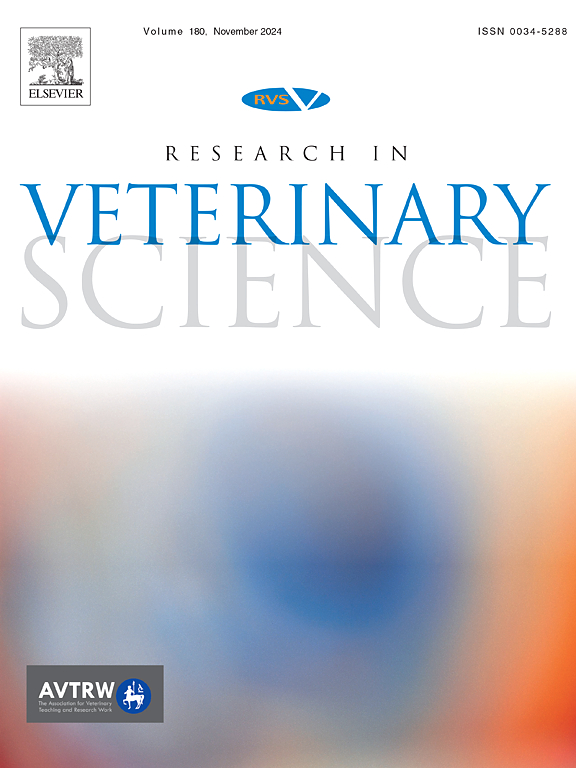长途旅行马的运输相关呼吸道病原体:到达屠宰场的前瞻性研究。
IF 2.2
3区 农林科学
Q1 VETERINARY SCIENCES
引用次数: 0
摘要
呼吸道疾病(rd)是马常见的运输相关的福利后果。这项前瞻性研究描述了运往意大利两个屠宰场的马的旅程,记录了可能与rd相关的病原体的流行情况,并确定了可能的诱发因素。数据记录从到达到到达后48小时,包括收集深鼻咽拭子(DNS),行程细节和马的福利评估(n = 155)。采用PCR定量检测甲型流感病毒、呼肠孤病毒、马1型和4型疱疹病毒、腺病毒、鼻病毒、星状病毒、马冠状病毒、巴氏杆菌、马链球菌亚种和动物流行病亚种的存在情况。每匹马的呼肠孤病毒和鼻病毒检测呈阳性,两匹马的腺病毒检测呈阳性。马链球菌、动物流行病和巴氏杆菌的检出率分别为4%、19%和63%。链球菌科和巴氏杆菌科与发汗有关(P本文章由计算机程序翻译,如有差异,请以英文原文为准。
Transport-related respiratory pathogens in horses travelling long distances: A prospective study on arrival at the slaughterhouse
Respiratory disorders (RDs) are a common transport-related welfare consequence in horses. This prospective study described the journeys of horses transported to two slaughterhouses in Italy, documented the prevalence of potentially RD-related pathogens, and identified possible predisposing factors. Data were recorded from arrival until 48 h after arrival and included the collection of Deep Nasopharyngeal Swabs (DNS), journey details and welfare assessment of horses (n = 155). PCR was used to quantify the presence of influenza A virus, reovirus, equine herpesvirus type 1 and 4, adenovirus, rhinovirus, astrovirus, equine coronavirus, Pasteurellaceae, Streptococcus equi sub. equi and sub. zooepidemicus. One horse each tested positive for reovirus, and rhinovirus and two horses tested positive for adenovirus. The prevalence of Streptococcus equi and zooepidemicus and Pasteurellaceae was 4 %, 19 % and 63 % respectively. Streptococcaceae and Pasteurellaceae were associated with sweating (P < 0.001). In addition, Streptococcaceae was associated with abnormal demeanour (P = 0.003), nasal or ocular discharge (P < 0.001) and higher compromised welfare after transport (P < 0.001). The multivariable regression analysis showed that broken horses departing from Eastern Europe or France were more likely to test positive for Streptococcaceae than unbroken horses coming from Poland (model P < 0.001), while broken horses subjected to short stops en route were more likely to test positive for Pasteurellaceae than unbroken horses on journeys without stops (model P < 0.001). Our findings increase the understanding of predisposing factors for RDs and may be useful in the implementation of regulations to protect the welfare of horse during transport.
求助全文
通过发布文献求助,成功后即可免费获取论文全文。
去求助
来源期刊

Research in veterinary science
农林科学-兽医学
CiteScore
4.40
自引率
4.20%
发文量
312
审稿时长
75 days
期刊介绍:
Research in Veterinary Science is an International multi-disciplinary journal publishing original articles, reviews and short communications of a high scientific and ethical standard in all aspects of veterinary and biomedical research.
The primary aim of the journal is to inform veterinary and biomedical scientists of significant advances in veterinary and related research through prompt publication and dissemination. Secondly, the journal aims to provide a general multi-disciplinary forum for discussion and debate of news and issues concerning veterinary science. Thirdly, to promote the dissemination of knowledge to a broader range of professions, globally.
High quality papers on all species of animals are considered, particularly those considered to be of high scientific importance and originality, and with interdisciplinary interest. The journal encourages papers providing results that have clear implications for understanding disease pathogenesis and for the development of control measures or treatments, as well as those dealing with a comparative biomedical approach, which represents a substantial improvement to animal and human health.
Studies without a robust scientific hypothesis or that are preliminary, or of weak originality, as well as negative results, are not appropriate for the journal. Furthermore, observational approaches, case studies or field reports lacking an advancement in general knowledge do not fall within the scope of the journal.
 求助内容:
求助内容: 应助结果提醒方式:
应助结果提醒方式:


